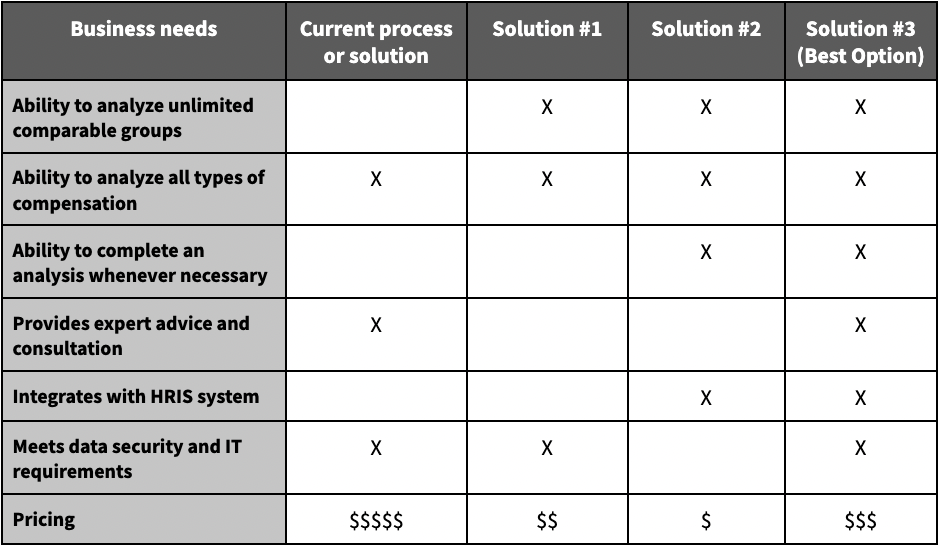If you found your way to this article, odds are that you already understand how technology can help you address pay equity in a more proactive, ongoing, and sustainable way — and you’ve decided to invest in a pay equity platform. But now, you need to sell your leadership team on it — here’s how.
Related content: If you haven’t chosen a platform yet, start by evaluating your options with this Pay Equity Provider Checklist.
5 questions to answer in a successful pay equity platform business case
1. What are your goals?
In order to paint the full picture of why you need a solution (and why now), you need to demonstrate how the solution will help you reach your pay equity and overall business goals. When making a business case for a pay equity platform, we recommend answering the following questions:
- What is your current process? Are you already conducting a pay equity analysis and want to continue doing so in a more proactive way? Or will this be a first time for your organization?
- What DEI&B commitments has your company made and communicated — whether internally or publicly (e.g., DEI&B-related values, board-level reporting, commitments to employees)? How does pay equity fit into those goals?
- What people/human capital goals do you have, such as employer brand, hiring, or engagement goals?
- What dimensions of pay equity do you want to consider (e.g., gender, race, age, disability, base pay, equity/stock, bonuses)?
- How frequently do you need to know where you stand on pay equity? Yearly, bi-annually, quarterly, or more frequently?
- What do you want the outcomes of an analysis to be (e.g., remediating pay inequities, preventing disparities from forming, satisfying legal reporting requirements, communicating progress internally or publicly, informing pay policy decisions, determining fair starting pay for new hires, pursuing third-party pay equity certification)?
- What are your data security standards and requirements?
2. What challenges are in the way of those goals?
Then, provide a brief overview of the challenges, roadblocks, and limitations you’re facing in trying to reach those goals. When it comes to pay equity analyses, these are some of the common challenges we hear:
- Current analysis processes are manual and take too long, meaning results are out of date by the time you receive them
- The results you receive don’t paint the full picture of why the inequities are happening in the first place. Are you really paying for performance? Are gaps isolated to certain managers? Are the geographic differentials you are considering during post-COVID impacting your pay equity results? You want to have more insight, so you can fix inequities long-term.
- It is often difficult to run the analysis quickly enough to do so during the very tight merit review window — so the pay equity analysis results do not incorporate merit adjustments.
- You can only look at pay equity once per year, which allows pay disparities to crop up and grow throughout the year. Remember: Your workforce is fluid and constantly changing so your solution needs to keep up.
- You really like your current vendor, but they are busy during the critical compensation season windows and you need the flexibility of an always-on tool.
- Your board or executives are asking detailed questions about where you stand on pay equity and how to close the gaps on an ongoing basis, and you need to get deeper into the data to answer these questions
- You wonder if there is a better way to approach making pay adjustments. Some of the adjustments proposed by your current vendor seem very large, and you wonder if there is something missing from the current approach.
- You don’t know if new hires are making the gaps worse. Your talent acquisition team sets starting salaries that are only informed by market rates — or market rates plus an eyeball of the pay of those currently in role — and not informed by how the new hire will impact the overall pay equity results.
- Employees and investors are asking a lot of questions about pay equity, and we don’t have accurate, up-to-date information to provide
- It’s becoming increasingly difficult to comply with new regulations.
Once you’re able to pinpoint your challenges, it’s important to tie those to business impacts. Are these challenges costing the company money? Are they hurting your employee engagement or retention? Is the lack of information causing friction in the boardroom? Basically, you want to make sure it’s clear why these challenges are a problem for the business and/or the bottom line.
3. How will a pay equity platform address those challenges?
You want to clearly show how a pay equity platform will alleviate those challenges you defined previously. We often see people focus on benefits in the following areas:
- Legal compliance
- Brand reputation
- Employee experience/human capital management
- Cost savings
- Board reporting
- ESG reports
- Ability to respond to calls for greater transparency from investors, employees, and customers
- The combination of always-on technology and advice from industry experts
You can add urgency to your business case by using stats and specific examples of how these challenges would hurt the business if left unaddressed. For example, according to Gartner’s Addressing Pay Equity found that for every year a business waits, or fails, to address inequity, the average remediation cost increases by $439,000. That’s a pretty compelling way to showcase why a solution is needed now.
It’s also important to tie these benefits to real-life situations and examples. This could mean giving very specific examples of how your current processes would change, calculating what your specific cost savings would be, or providing case studies and testimonials from other companies that have solved similar problems with this solution.
Work with your chosen solution provider when putting together this information, because they should be able to give you some resources that you can reuse or easily pull information from.
4. How do the available solutions align to your business needs?
Now that you’ve explained why you need a solution and how it will help you reach your goals, it’s time to explain why the solution you’ve chosen is the best option for your business. One of the easiest ways to do this is by showing a head-to-head comparison between your existing processes and the solutions you’ve evaluated.
For example, you could put together a comparison chart like the one below.

Every company’s solution comparison will look a little different based on their unique goals, but this general framework is often the easiest way to convey your message and make it clear what the best option is.
5. What is the implementation plan?
At this point, your leadership is hopefully already sold on your chosen solution. But it’s important to make sure they understand what will be required to implement the solution you’re proposing, so that everyone has the right expectations. You should clearly define:
- What stakeholders will need to be involved in the implementation process?
- What role will each of those stakeholders play and what are they responsible for?
- What is the timeline?
Your solution provider should be able to give you information about their onboarding and implementation process — so work with their team to see what materials they have.
Meeting today’s standards with your new technology
To help you get the most out of your new technology, our team of experts have created resources that walk through the steps you can take to move your organization to an ongoing, proactive pay equity strategy.
Interested in learning about how the Syndio platform has helped companies like Salesforce, Nordstrom, and General Mills modernize their pay equity strategy? Request a demo.


